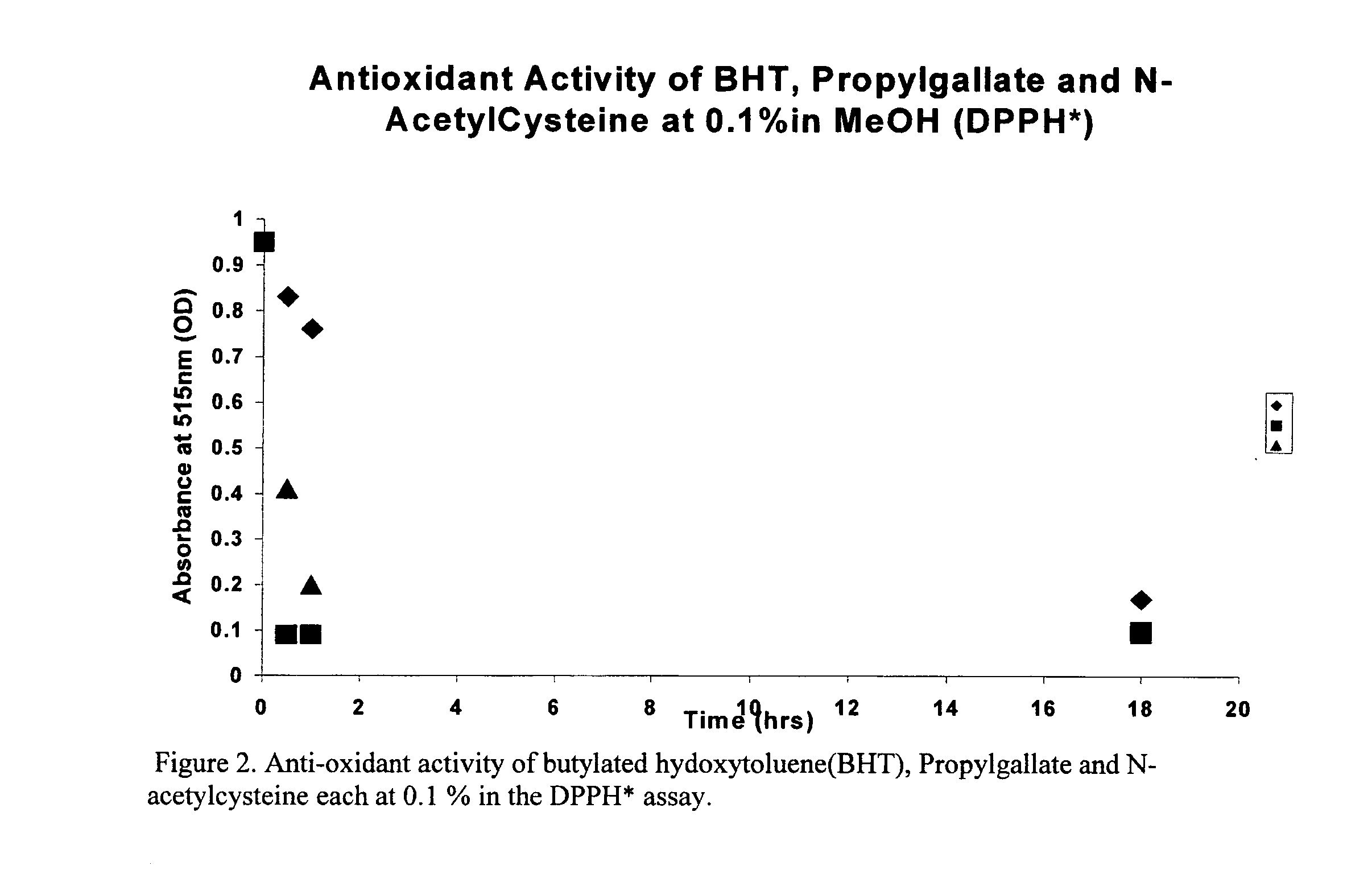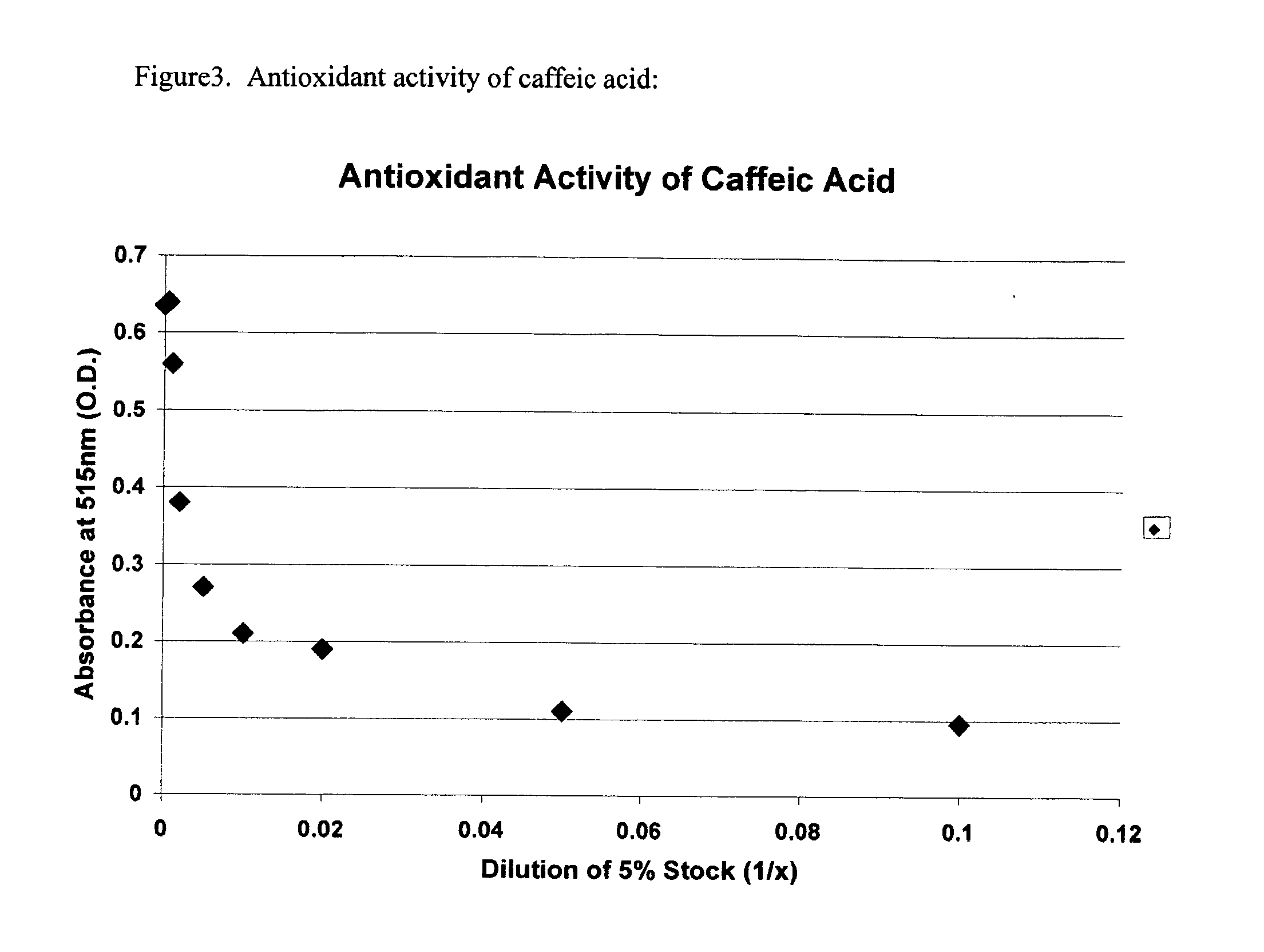Prophylactic and therapeutic treatment of topical and transdermal drug-induced skin reactions
- Summary
- Abstract
- Description
- Claims
- Application Information
AI Technical Summary
Benefits of technology
Problems solved by technology
Method used
Image
Examples
example 1
Antioxidant Activity of Hydroxybenzoic acids
Anti-Oxidant Assay:
[0083] Solutions of test compounds were assayed for their antioxidant activity by the free-radical scavenging method that uses diphenylpicryl hydrazine (DPPH*) reagent as described previously (Bonina et al, 2003). In order to standardize the activity, we defined for each compound, an EC50 value as the concentration that lowers the zero time optical absorbance of DPPH at 595 nm by 50 percent measured after 30 minutes of incubation at 25° C.
Antioxidant Activity of Test Compounds:
[0084]FIG. 1 shows a typical plot of antioxidant activity for several standard antioxidants as assayed by the DPPH* method. The molar activities of ascorbic acid, ascorbyl palmitate and vitamin E were calculated as 26 μM, 30 μM and 46 μM, respectively. Indole acetic acid, a weak free-radical scavenger and plant hormone, had a molar activity of 190 μM. Finally a commercially purchased flavonoid, quercetin dihydrate, had an intermediate molar a...
example 2
Biochemical Assay for Detection of Anti-Irritant Activity
[0087] Since retinoids irritate skin leading to epidermal hyperplasia, we have employed an in vitro cell culture method to detect antioxidants that act to inhibit retinoid-stimulated autocrine growth of human keratinocytes.
[0088] Method: An immortalized line of human epidermal kertatinocytes, HaCat keratinocytes, can be cultured in a serum-free culture medium. Sterile Petri dishes (35 mm2) are seeded at 5,000 cells per cm2 and placed in a humidifed CO2 incubator at 37° C. for 3-5 days or until the culture reaches about 30% confluent monolayer growth. The dishes are washed once with ice-cold serum-free media lacking EGF and insulin, and refed 2.5 ml of serum-free culture medium containing 5 ug / ml insulin and retinyl acetate (RA, 3×10−8 M). Duplicate control dishes are fixed and stained with 0.2% crystal violet to record the amount of clonal growth prior to refeeding with fresh RA-containing medium. Test dishes refed RA and in...
example 3
In Vivo Test for Anti-Irritant Activity of Hydroxybenzoic Acid Compounds
Anti-Irritant Activity of Gallic Acid and Green Tea Extracts
[0090] Occlusive patch testing was conducted on extracts prepared by starch gel encapsulation in a oil-in water emulsion system previously described (Wille, 2003). FIG. 8 presents results showing that a 5% Green Tea Leaf extract in vehicle gel elevated skin hydration following 24-hour occlusion when co-administered in the carrier gel with an irritating amount of benzalkonium chloride (0.5%). FIG. 9 presents results showing that gallic acid is not irritating to skin and does not alter skin hydration profile after 24 hours of occlusion and FIG. 10 shows the anti-irritant effect Gallic acid on benzalkonjium chloride induced skin irritation under 24 hour occlusion.
[0091] Anti-irritant assays: All carrier system gels were prepared with 0.5% benzalkonium chloride, a mild irritant. To test for anti-irritancy, the irritant-containing carrier gels were also ...
PUM
 Login to View More
Login to View More Abstract
Description
Claims
Application Information
 Login to View More
Login to View More - R&D
- Intellectual Property
- Life Sciences
- Materials
- Tech Scout
- Unparalleled Data Quality
- Higher Quality Content
- 60% Fewer Hallucinations
Browse by: Latest US Patents, China's latest patents, Technical Efficacy Thesaurus, Application Domain, Technology Topic, Popular Technical Reports.
© 2025 PatSnap. All rights reserved.Legal|Privacy policy|Modern Slavery Act Transparency Statement|Sitemap|About US| Contact US: help@patsnap.com



